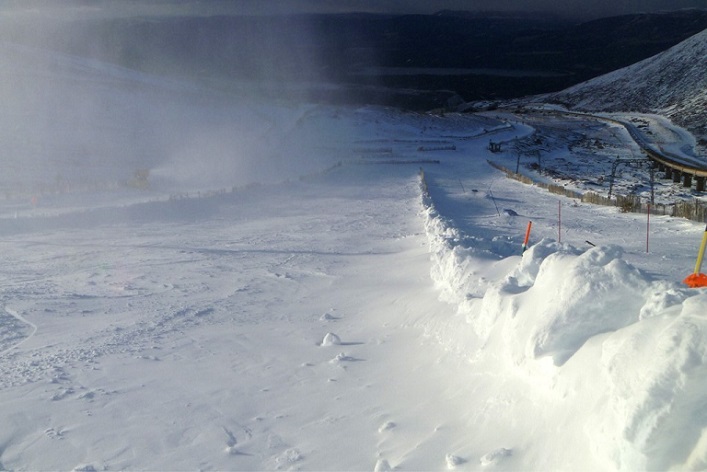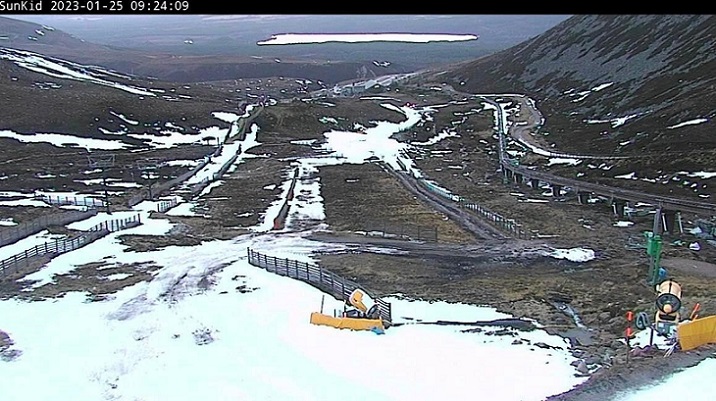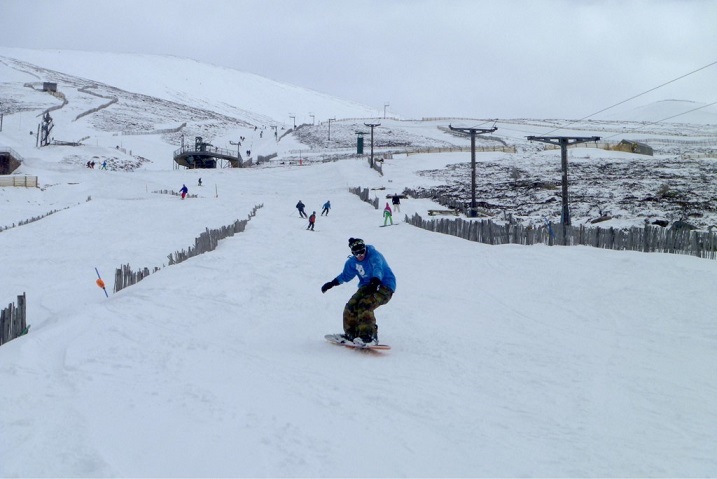Yesterday, Highlands and Islands Enterprise announced (see here), earlier than anticipated, that the funicular would start operating on today (26th January) after the Department of Transport had provided authorisation under the Cableway Installation Regulations 2018 for it to re-open. While this should at last provide a reasonably reliable means of access to the upper lifts in Coire Cas and the Ptarmigan Bowl, the capacity of the funicular is limited and in unlikely to draw snowsports enthusiasts back to Cairn Gorm unless far better use is made of other uplift.
Earlier on the 25th, the CairnGorm Mountain early morning report made another announcement which illustrated the problem:
‘‘We have lost too much snow on the lower Mountain to Operate the Car Park T-Bar and the route back to base from the mid station is now broken’’.
That was after a thaw that had lasted for two days, up to that point.

The picture shows that machine made snow can be produced for use on the Car Park T-Bar uptrack. If that had been done this season then the uptrack would not have been lost after two days of thawing. In fact, the tow could have been in use on opening day, 17th December 2022 and continuously since then. Regrettably, there has been no effort to put down Fan Gun produced snow on the T-Bar uptrack, at any time this season.
It’s also the case that the route back to the Daylodge has not been maintained with Fan Gun snow. This is completely at odds with what the CEO of Cairngorm Mountain Scotland Ltd, Highlands and Islands Enterprise fully owned subsidiary, had to say:
‘’Our strategy is to operate effectively & to create and maintain a skiable run from mid-station to base-station’’
The implementation of that strategy has been an absolute failure as evidenced by the picture below.

The screenshot shows how there was no complete run from mid-station to base-station. But it also shows that where natural snow is supplemented by fan gun snow, produced in sufficient quantities to reach critical mass, it survives thaw periods much more resiliently than natural snow alone. The fan gun on the centre left of the picture has been in use and the snow is still there. The one on the right, which is pointing to the top of the Sunkid Rope Tow, has not been used and the outcome is bare ground. The snow made by the fan gun that’s adjacent to the rope tow control hut in the middle distance and has been used more than most is still very much in evidence. When snow survives through thaw periods, snowsports can be continuously provided while the increased numbers of operational runs and lifts attract more visitors..
In recent correspondence received from the CMSL CEO, Susan Smith, she claimed that generators for the fan guns were ordered and delivered to the hill in mid-December. I was pleased to receive that information because it proved what I had argued previously (see here), that snow making was not undertaken, in any optimal way, during the time period between 5th and 15th December. In other words, the generators were ordered/delivered too late to take advantage of the cold weather in early December.
The CEO was also at lengths to explain in her letter that temperatures have to be below -2C before snow can be made and that there needs to be little or no wind. That too was pleasing to hear because the prevailing weather in December between 5th and 15th was windless most of the time and temperatures were continuously below -2C.
The fact that the lower slopes in Coire Cas have already been lost twice this season points to the sub-optimal use of the snowmaking equipment.
The information from Susan Smith confirms that the fan guns have not been in use in any meaningful way. It seems that there is a failure on the part of HIE to understand how snowmaking can be of benefit. Making sufficient snow to ‘get up and running’ in the beginners area and leaving it at that simply leaves the pistes vulnerable to any thaws. If the conditions allow, as they did in December 2022, then sufficient artificial snow needs to be made to reach critical mass so that pistes and uplift survive thaw periods.

A cost benefit analysis is urgently required so that decisions about making snow are based on real data not just knee jerk reactions to the fact that it is costly. The Save the Ciste campaign has professional in-house expertise that was used previously to conduct detailed accumulation and ablation modelling based on real data. Using that modelling, the depth of snow that is required to get through different lengths and severities of thaw can be calculated and the production costs determined. Relationships to revenue can then be factored in and decisions made accordingly.
If CMSL would like to have that level of analysis then the STC campaign would be pleased to act on a paid consultancy basis and undertake the work, without delay.
As things stands today [Thursday 26th January 2023] snowsports enthusiasts will have to catch the funicular, which will have to make mid-station stops, to get back down to base station. Previous analysis by the STC campaign provided evidence which showed that the lack of a complete piste from mid-station to base-station is a major factor in decisions about whether to go to Cairn Gorm or go elsewhere. After any initial bounceback afforded by the re-opened funicular providing more reliable access to different parts of the mountain, the likelihood is many potential customers will give Cairn Gorm a miss except when they can ski/board back to base. This is a real shame because, as well as a significant loss of revenue for the hill business and the wider area, it does not need to be that way.
What needs to happen
It is time a professionally qualified CEO with snowsports area management experience is found and appointed to manage the hill business. £30m of public money has been stumped up recently to prop up this business and it’s very evident that the necessary managerial competence, capable of providing a return on that investment, is missing.
For change to happen, the Cairn Gorm estate and CMSL need to be handed over to the local Community Trust by Scottish Ministers and HIE’s involvement restricted to retaining all financial liability for the funicular.
Source link
